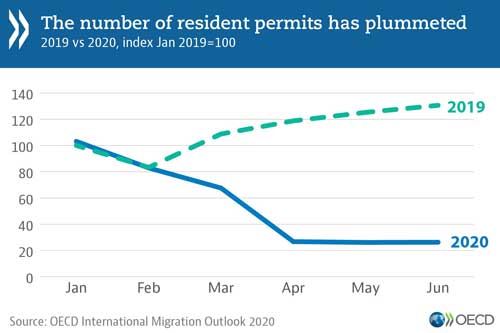Migration flows have increased over the past decade and some progress has been made to improve the integration of immigrants in the host countries. But some of these gains may be erased by the COVID-19 pandemic and its economic fallout. Governments need to secure the health and safety of all workers in essential activities and maintain spending on integration to help migrants continue to contribute to society and the economy, according to a new OECD report.
The says that the COVID-19 crisis has had unprecedented consequences on migration flows. Before the pandemic, permanent migration flows to the OECD amounted to 5.3 million in 2019, with similar figures for 2017 and 2018. Although there were fewer refugee admissions, permanent labour migration rose by more than 13% in 2019 and temporary labour migration also rose, with more than 5 million entries recorded in the OECD.
Following the onset of the pandemic, almost all OECD countries restricted admission to foreigners.
 As a result, issuances of new visas and permits in OECD countries plummeted by 46% in the first half of 2020, compared with the same period in 2019. This is the largest drop ever recorded. In the second quarter, the decline was 72%. Overall, 2020 is expected to be a historical low for international migration in the OECD area.
As a result, issuances of new visas and permits in OECD countries plummeted by 46% in the first half of 2020, compared with the same period in 2019. This is the largest drop ever recorded. In the second quarter, the decline was 72%. Overall, 2020 is expected to be a historical low for international migration in the OECD area.
There are strong signs that mobility will not return to previous levels for some time. This is due to weaker labour demand, persistent severe travel restrictions as well as the widespread use of teleworking among high-skilled workers and remote learning by students.
“Migration will continue to play an important role for economic growth and innovation, as well as in responding to rapidly changing labour markets,” said OECD Secretary-General Angel Gurría, launching the report with European Commissioner for ³Ô¹ÏÍøÕ¾ Affairs Ylva Johansson. “We need to avoid rolling back on integration and reaffirm that migration is an integral part of our lives.”
Migrant workers have been on the frontline of the crisis. They account for a large share of the OECD medical workforce, with one in four medical doctors in the OECD, and one in six nurses. In many OECD countries, more than a third of the workforce in other key sectors, such as transport, cleaning, food manufacturing and IT services, are immigrants.
Yet immigrants are facing a hard time in the labour market. Much of the past decade’s progress in employment rates among immigrants has been wiped out by the pandemic. In all countries for which data are available, immigrants’ unemployment increased more, compared to their native-born peers. The largest increases for immigrants were observed in Canada, Norway, Spain, Sweden and the United States. In Sweden, almost 60% of the initial increase in unemployment fell on immigrants. In the United States, unemployment of immigrants was lower than their native-born peers by almost one percentage point before the pandemic, it is now 2 percentage points higher.
Migrants are highly exposed to the health impacts of the pandemic as a result of working on the frontline during the pandemic but also vulnerabilities linked, for example, to housing conditions and poverty. Studies in a number of OECD countries found an infection risk that is at least twice as high as that of the native-born.
Going forward, getting migration and integration policies right will be essential if we are to achieve a strong and truly inclusive recovery.
Read the and the .








